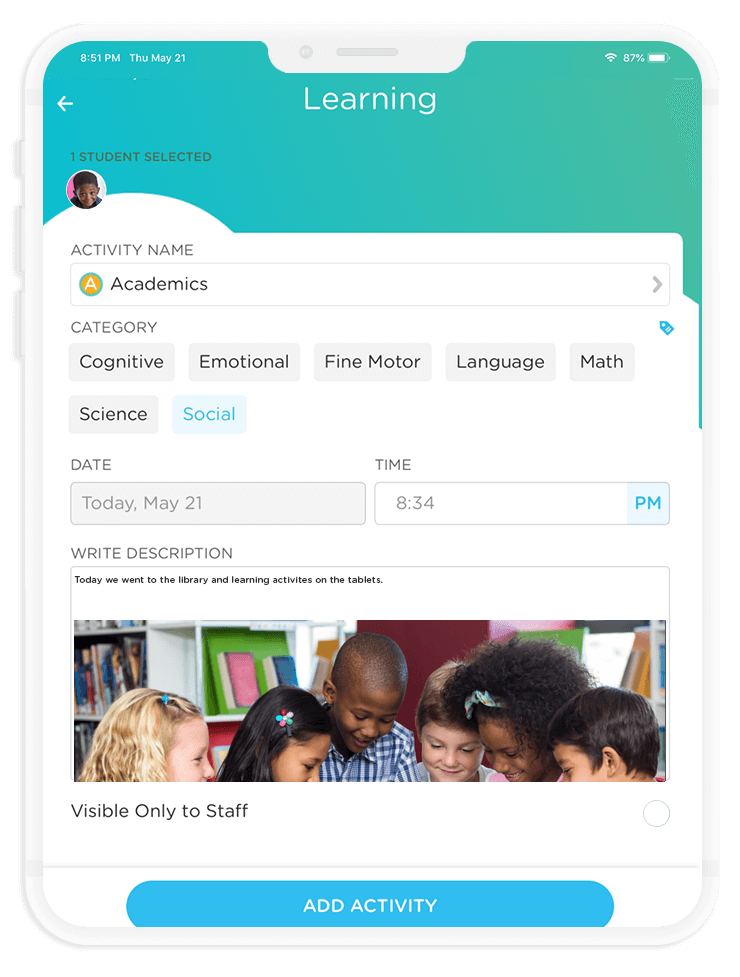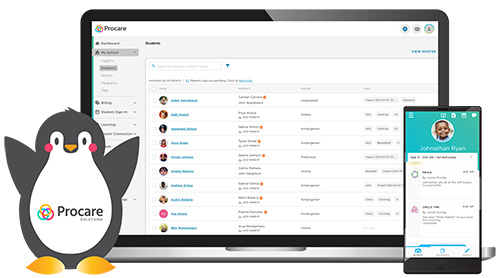
Creating child care portfolios that tell the unique learning story of each child is a great way to set your center apart. Portfolios help support learning outcomes, nurture parent engagement, and give you a reflective tool for continuous improvement of your learning activities.
Best of all, child care portfolios are easy to integrate into the record-keeping you’re already doing, and help make those records even more useful — especially with digital record-keeping. In this post, we’ll talk about what a child care portfolio looks like, why you should create them for kids at your center, and how you can put together the most effective portfolio for every child.
What is a Child Care Portfolio?
A child care portfolio is a structured collection of records that gives an individualized portrait of a child’s development over time at your center. It captures the child’s unique self, their progress and their place in your child care community. The portfolio can be digital, physical or both.
With a child care portfolio, you can keep track of each child’s learning outcomes at your center, identify patterns in their behavior and development, and communicate your activities and curriculum to parents. Portfolios should be worked on and added to regularly for the greatest accuracy, and curated for parents at the end of the year.
Child care portfolios are a collaborative tool between you, the child and the parents. They’re a great way to encourage reflection from children and feedback for parents, while giving you the opportunity to highlight the best in each child and your center as a whole.
Why Are Child Care Portfolios Important?
Child care portfolios are an exciting project because they align several of your ongoing educational activities. By planning for all of your observations and reports to contribute to a portfolio, you’ll have a vision and purpose that lets you maximize their impact.
Portfolios help document classroom experiences, giving parents a window into your class. They form a useful extension of your tracking of child developmental progress, helping you translate your daily observations into a big-picture narrative. This narrative lets you connect parents with their children’s development, turning an abstract set of scores and evaluations into a timeline they can see firsthand.
Having portfolio additions in mind in advance helps you be more intentional and individual in lesson planning, giving you a concrete way to think about outcomes for each child. Reflecting on the portfolios afterward will also give you insight into what works and doesn’t in your lessons.
What Should Be Included in a Child Care Portfolio?

A child care portfolio highlights materials that illustrate a child’s unique learning journey. No two portfolios will be exactly alike, just as no two kids are! Choose the items that best reflect the child’s personality, interests and progress.
Here are some ideas on resources to pull from to build your child care portfolios:
- Photos of experiences, lessons and activities. Parents and kids alike love to look at photos. Photos capture spontaneous moments that reflect a child’s personality or learning progress.
- Photos of child creations. Photos can help you memorialize collaborative projects or other work that may not be easily included in a physical portfolio.
- Art samples. Actively involve kids in choosing which pieces to include and recording their thoughts and reflections on what they created.
- Anecdotal notes and observations. Your observations of the child are a valuable resource. They’re most effective when you record them in detail while they’re still fresh, such as by using a child tracking app on your phone.
- Child writing samples. For kids who have learned to write, writing samples give both a concrete example of the child’s thoughts and experiences in their own words, and a look into their progress in the language and literacy domain.
- Descriptions of conversations with the child. Even better, record a quick video or audio clip so that parents can listen to the real thing. That makes it easier to transcribe the conversation faithfully, too.
Family Accounting
How to Make a Child Care Portfolio
Create a physical or digital portfolio, or both.
Physical and digital portfolios have complementary benefits. Physical portfolios contain more tangible memories, like the child’s original artwork. They allow for a visual layout of portfolio pieces, or for items to be displayed separately.
Digital portfolios, on the other hand, are more permanent and copyable, letting families share them instantly with friends and relatives. It’s easier to add photos and other memories, and digital portfolios allow the inclusion of video, too.
Even if you’re creating a primarily physical portfolio, digital records can supplement your documentation. Don’t discount the potential of using physical and digital together, so that parents can have originals while you save time on collection.
Divide portfolio entries by learning domain.
To best showcase the progress of the whole child, it’s important to include entries from each learning domain, categorized so that parents can understand outcomes in every area. Consider what materials will best capture results in each domain, and how often you should add to the portfolio to most effectively convey their development.
Not all learning domains may have tangible work associated with them, so photos and written observations are helpful here. For instance, for social and emotional development, you may want to share a video of a child playing with their best friend in the classroom.
Include day, month, and year with every entry.
One of the key benefits of a portfolio is tracking developmental progress over time, so you’ll definitely want to include the exact date on each of your records. That way you can effortlessly pick out key dates and arrange pieces in order. The easiest way to make sure you do this is by tracking artifacts digitally, since the date will be automatically included.
Curate portfolio entries to show progress.
Portfolio entries should be highlights that contribute to the child’s unique story at your center. Your portfolios will be more interesting, memorable and easy to view if you make an effort to only include the most important and interesting materials.
Consider in advance what standards you’ll apply to curation, and so that you’ll find it easy to decide what is and isn’t worth including. Getting the child involved is helpful here — seeing what items kids get excited about will help you choose, and encourages self-reflection.
Set outcome goals for every child.
To ensure that your portfolios are documenting progress and highlighting the benefits of being at your center, you’ll need to connect the portfolios to outcome goals. Tying your records back to your state or Montessori early learning standards will let you measure each child’s development in an objective way.
Beyond using standards, it’s also important to consider each child’s individual needs and what goals may matter most to their development. This also reassures parents that you view their child as an individual.
Share child care portfolios with parents.
Child care portfolios can be shared with parents on an ongoing basis throughout the year, or you can hold a “portfolio presentation day” where parents get to see their kids’ portfolios presented as a whole. Or, you can do both, involving parents regularly in the curation and structure of their child’s portfolios.
Choose the right format and make sure the portfolio is laid out in an aesthetically pleasing, comprehensible way. The professionalism of your portfolios reflects on your center, so this is your opportunity to impress and engage parents and show them your passion for caring for each child.
Create and Share Digital Child Care Portfolios with Procare Solutions

Between daily duties like organizing activities, preparing meals, and providing routine care, it can feel difficult to set aside time for creating and updating child care portfolios.
But with Procare’s easy-to-use parent engagement app, you will have the tools you need at your fingertips to record observations, track the developmental progress of each child, and send engaging updates to parents at the touch of a button.
It’s part of Procare’s child care management software, your all-in-one solution for managing every aspect of your center. With Procare, your records are wherever you need them in your child care platform, uniting your early childhood learning goals, classroom activity tracking, child care security procedures and more, all in one place.
Ready to see how Procare can help you impress parents and nurture the individual development of each child?





